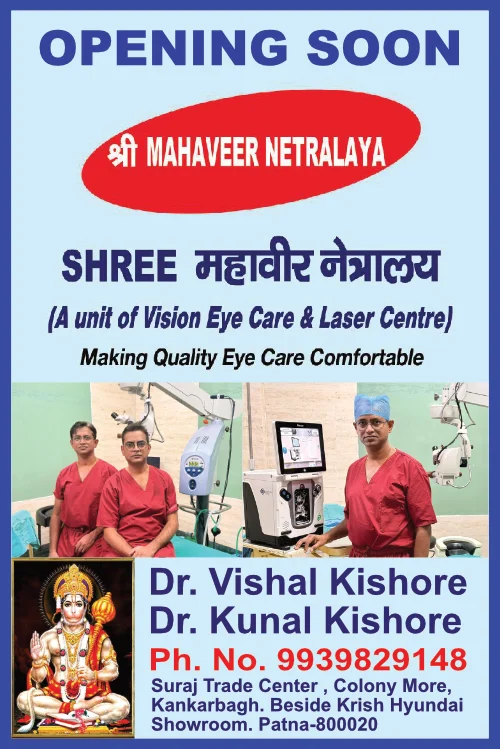
Surgical Procedure
Strabismus
All Treatments
Strabismus
Correcting Eye Misalignment for Better Vision
Strabismus, commonly known as crossed eyes or squint, is a condition in which the eyes do not align properly. One eye may turn inward, outward, upward, or downward while the other eye looks straight ahead. This misalignment can be constant or intermittent and may affect one or both eyes. Strabismus can occur at any age, but it is most common in children. Our clinic offers comprehensive diagnosis and treatment for strabismus to restore proper alignment and improve visual function.

What is Strabismus?
Strabismus is a condition where the eyes are unable to focus on the same point at the same time. This occurs when the muscles that control eye movement fail to work together, causing one eye to deviate from the normal line of sight. The misalignment can lead to problems with depth perception and, if left untreated, can result in amblyopia (lazy eye), where the brain ignores signals from the misaligned eye, causing permanent vision loss.
Types of Strabismus
Strabismus can vary depending on the direction of eye misalignment and its frequency. The common types include:
- Esotropia: One or both eyes turn inward toward the nose (crossed eyes). It is the most common form of strabismus in young children.
- Exotropia: One or both eyes turn outward, away from the nose. This form is often more noticeable when the child is tired or daydreaming.
- Hypertropia: One eye turns upward, while the other eye remains straight.
- Hypotropia: One eye turns downward, while the other eye remains straight. Strabismus can also be classified as constant or intermittent based on how often the eye misalignment occurs.
Symptoms of Strabismus
- Eye Misalignment: The most obvious sign is that one eye appears to be looking in a different direction.
- Double Vision: In some cases, the person may experience seeing two images of a single object.
- Eye Strain or Fatigue: The eyes may feel tired after prolonged use, especially when reading or focusing on close tasks.
- Head Tilting or Turning: Individuals may tilt their head to use one eye more than the other to avoid double vision.
- Loss of Depth Perception: Strabismus can affect the ability to judge distances or see in three dimensions.
Diagnosis and Evaluation of Strabismus
Early diagnosis is essential to prevent permanent vision problems. Our clinic uses advanced diagnostic tools and tests to determine the type and severity of strabismus. A comprehensive eye examination includes:
- Visual Acuity Test: To assess the sharpness of vision in each eye.
- Corneal Light Reflex Test: To detect misalignment by observing the reflection of light in the eyes.
- Cover Test: A simple and effective way to diagnose strabismus by covering one eye and observing the movement of the other.
- Retinal Examination: A detailed assessment of the back of the eye to check for underlying conditions.
Treatment Options for Strabismus
The goal of strabismus treatment is to align the eyes, improve visual function, and prevent amblyopia. Depending on the type and severity of the condition, treatment options may include:
- Corrective Glasses: For some types of strabismus, particularly those associated with refractive errors, glasses can help align the eyes and correct vision.
- Patching Therapy: In cases of amblyopia caused by strabismus, the stronger eye may be patched to encourage the brain to use the weaker eye, improving its function.
- Prism Lenses: These specialized lenses help bend light and reduce the need for eye alignment, easing strain and improving vision.
- Vision Therapy: Exercises designed to strengthen the eye muscles and improve coordination. Vision therapy can be an effective non-surgical option for treating certain forms of strabismus.
- Botox Injections: In some cases, botulinum toxin can be injected into the eye muscles to temporarily weaken them, helping to realign the eyes.
- Strabismus Surgery: In more severe cases or when other treatments are not effective, surgical intervention may be necessary. The surgery involves adjusting the muscles that control eye movement to improve alignment. This is typically an outpatient procedure with a relatively quick recovery time.
Recovery and Long-Term Management
After treatment or surgery, follow-up care is important to ensure proper healing and to monitor the alignment of the eyes. In some cases, additional therapy or glasses may be needed to maintain eye alignment and prevent recurrence of the condition. Our clinic offers personalized care plans for long-term management of strabismus, ensuring the best possible outcome for each patient.
Frequently Asked Questions:
- Can strabismus go away on its own? In most cases, strabismus does not resolve without treatment. Early intervention is crucial to prevent complications like amblyopia.
- Is surgery always necessary for strabismus? Not always. Glasses, vision therapy, and other non-surgical treatments are often effective, especially in mild or intermittent cases.
- Can adults develop strabismus? Yes, strabismus can develop in adulthood due to conditions like stroke, trauma, or neurological issues. Treatment is still effective in aligning the eyes and improving vision.
Schedule Your Strabismus Consultation
If you or your child are experiencing symptoms of strabismus, early diagnosis and treatment can prevent long-term vision problems. Our clinic offers expert care in managing and correcting strabismus through a variety of treatment options. Contact us today to schedule your consultation and explore the best treatment plan for you.
 +91 9939829148
+91 9939829148 visionlasercentre@gmail.com
visionlasercentre@gmail.com +91 7761882875
+91 7761882875
